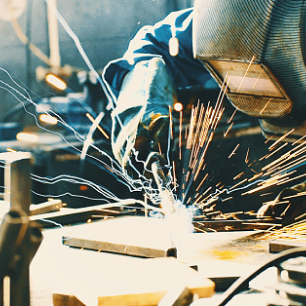Jump to:
AWS D1.1 2025 Introduces a New Grade of Structural Steel for Prequalified Welding
AWS D1.1/D1.1.M:2025, Structural Welding Code — Steel (pubs.aws.org), marks the 25th edition of the D1.1 code, and with it comes a new grade of structural steel that’s now the strongest base metal approved for prequalified welding. At a minimum yield strength of 80 ksi and a tensile strength of 95 ksi, A913 Gr80 is the only prequalified base metal in its strength category.
Traditionally, high-strength steels have achieved their desired mechanical properties through the addition of alloying elements, which negatively affect their welding characteristics. Increasing the strength of these steels generally decreases weldability, requiring higher pre-heats and increasing the risk of base metal cracking. For this reason, A913 Gr80 required comprehensive research and an extensive vetting process to prove that the material would be safe for prequalified welding despite the higher strength level.
What Makes A913 Different?
Unlike traditional steels, A913 achieves its strength through a process known as quenching and self-tempering (QST). The QST process occurs directly after the steel sections are rolled. The hot steel sections (approximately 1600°F) are subjected to swift, controlled cooling (quenching), which lowers the exterior temperature of the steel section but allows the cross section’s core to retain heat. The residual heat within the core facilitates self-tempering as the heat migrates from the core back to the surface. This process provides additional strength without negatively affecting the ductility or weldability of the steel, thereby allowing the production of higher-strength steel with lower alloy content.
Since being introduced into ASTM in 1993, the A913 grade constantly challenged the notion that high-strength steels are inherently more difficult to weld. The A913 grade is specifically limited to rolled steel shapes and is most commonly available in large, wide flange sections. Its combination of size, strength, and weldability has made this grade popular for strength-controlled elements in steel buildings for applications such as gravity columns and trusses. A913 is currently available in four grades: Gr50, Gr65, Gr70, and Gr80, with A913 Gr80 being most recently introduced in 2019.
When comparing A913 to other grades commonly specified for structural steel sections (A992 and A572), A913 can achieve a higher strength with a lower carbon content and similar carbon equivalent value. These properties directly translate to better welding characteristics. Prior to the advent of Gr80, AWS D1.1 had already incorporated some of these advantages into the welding code by adding A913 Gr50 and Gr65 into preheat Category D. This category allows for the prequalified welding of these grades without preheat, provided the ambient temperature is above 32°F and an electrode with a diffusible hydrogen content of 8 mL/100 g (H8) or less is utilized. If the ambient temperature drops below 32°F, a preheat to 70°F is required. If the electrode does not meet the diffusible hydrogen content of Category D, prequalified welding is still permitted, but a more restrictive preheat category must be used.
What’s New for 2025?
The 25th edition of the D1.1 allows fabricators to further take advantage of the excellent welding properties of A913 steel. The most notable change is the addition of A913 Gr80 as a prequalified base metal. The introduction of this steel to D1.1 required the addition of a new category (Group V) to the table for approved base metals, as well as the introduction of approved matching electrodes and a new preheat category (Category G). The preheat temperatures in this category are identical to Category B, allowing for the prequalified welding of A913 Gr80 at the same temperature as A992 and A572 Gr50. Prequalified welding of A913 Gr80 will be limited to electrodes with a diffusible hydrogen content of 4 mL/100 g (H4) or less.
The new edition of the welding code also includes significant changes for A913 Gr65 and Gr70. A913 Gr65 has been moved from pre-heat Category C to Category B, which allows welding at lower temperatures when using an electrode with a diffusible hydrogen content higher than 8 mL/100 g (H8). A913 Gr65 also retains its status in Category D, allowing welding without preheat when the criteria of that category are met. The code also includes a new preheat category (Category F) for A913 Gr70, which will allow the welding of Gr70 with no preheat for sections up to 2½ in. thick and a preheat temperature of 150°F for sections greater than 2½ in. thick. The temperature and diffusible hydrogen limitations for this new category are identical to those in Category D.
How Can I Take Advantage of These Changes?
The recent changes to D1.1 have made A913 steel more user-friendly for fabricators, but it is important for project teams to properly identify where this grade of steel should be utilized on a project. Due to the nature of the QST process, A913 is not available in lighter sections, so the material is best utilized in strength-controlled structural elements that weigh more than 100 lb/ft, such as trusses, columns, and short-span beams. Since there is only a minimal cost premium for A913 compared to other grades (1–3%) and the material is available through multiple steel producers, any weight savings achieved using a higher grade directly translates to a reduction in material cost.
A913 steel can facilitate additional savings in fabrication and erection costs through the reduction of weld sizes, elimination of welded cover plates, and reduction in crane size due to lighter pick weights. For example, Fig. 1 demonstrates how a 32% weight saving utilizing A913 Gr80 generates a 52% decrease in weld volume for a complete joint penetration splice, as the thinner webs and flanges require significantly less passes to complete the splice. These cost savings are then compounded by welding A913 steel at a reduced preheat, as permitted in the recent updates to D1.1.
Conclusion
While these updates to D1.1 may be specific to one grade of steel, they also signal a paradigm shift in the way preheats are addressed in the code. Rather than simply relying on tensile strength to determine the acceptable preheat level, users can now apply these changes as part of a more holistic approach for determining preheat for prequalified welds. By considering factors such as chemical composition, hydrogen content, and restraint, preheat temperatures can be safely optimized for modern steels, benefiting fabricators, erectors, and the steel industry as a whole.
This article was written by Christopher Urtz, senior technical sales engineer, ArcelorMittal, for the American Welding Society.


